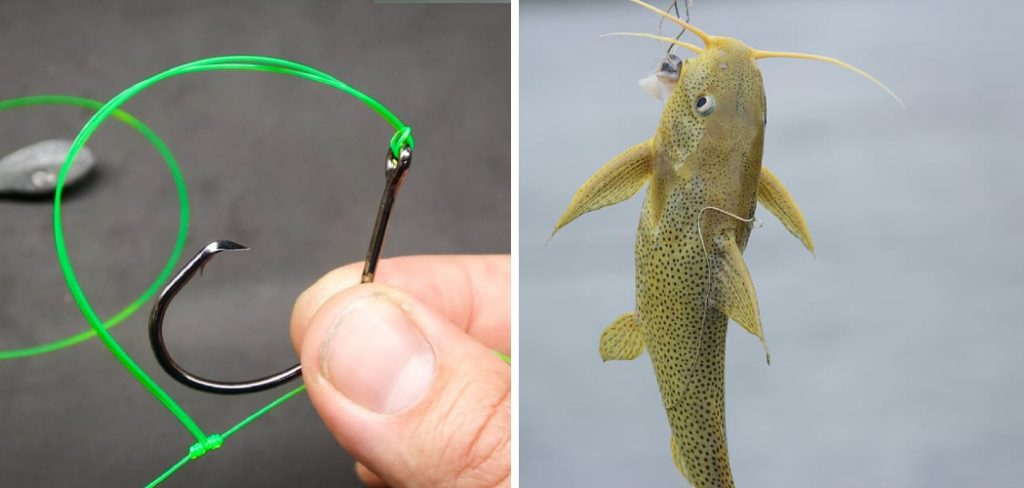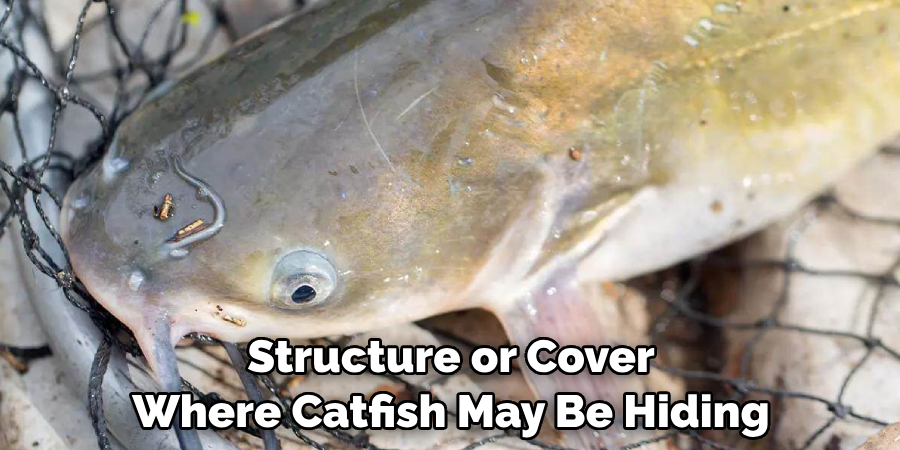Preparing your fishing line properly for catfish is a crucial step in ensuring a successful and rewarding angling experience. Catfish are known for their strength and tenacity, making it essential to have a well-rigged setup that can handle their powerful strikes. In this comprehensive guide, we’ll explore the step-by-step process of how to set up fishing line for catfish.

From choosing the right fishing rod and reel combination to selecting the appropriate line strength and rigging the proper terminal tackle, we’ll cover all the essential components to optimize your chances of landing a catfish successfully.
Whether you’re a beginner eager to learn the basics or an experienced angler looking to refine your catfishing gear, this guide will equip you with the knowledge needed to tackle these formidable freshwater species with confidence.
Importance of Setting up Fishing Line Specifically for Catfish
Fishing is a popular outdoor activity enjoyed by many people around the world. It not only provides a source of food but also serves as a recreational sport. Among the different types of fish that can be caught, catfish is one of the most sought after species due to its unique taste and size.
When it comes to catching catfish, setting up your fishing line correctly is crucial. Not only does it increase your chances of successfully catching a catfish, but it also ensures the safety and well-being of the fish. In this guide, we will discuss why it is important to set up your fishing line specifically for catfish.
Understanding Catfish Behavior
Before we delve into the importance of setting up your fishing line for catfish, it is essential to understand their behavior. Catfish are bottom feeders, meaning they primarily stay close to the lake or riverbed and feed on small aquatic creatures found there.
They have a keen sense of smell and are attracted to food sources with a strong scent. This knowledge is crucial in setting up your fishing line for catfish.
Proper Hook Size
The size of the hook you use is critical when targeting catfish. You want to ensure that the hook is big enough to handle the weight and strength of a catfish, but not too large that it scares them away. It is recommended to use a size 1/0 or 2/0 circle hook for catching catfish. These sizes are ideal for catching medium to large-sized catfish.
Strong and Durable Line
Catfish are known to be strong and powerful fish. They can put up a good fight when caught, so you want to make sure that your fishing line can withstand their strength. Using a heavy-duty monofilament or braided line with a test weight of at least 20 pounds is recommended for catching catfish.
10 Methods How to Set up Fishing Line for Catfish
1. Choose the Right Line

The first step in setting up your fishing line for catfish is to choose the right line. Catfish are strong and can put up a good fight, so you’ll want to use a strong and durable line. Braided lines or monofilament lines with a high pound test are recommended for catfish. These lines are less likely to break or get tangled when reeling in a large catfish.
2. Attach a Sinker
Next, attach a sinker to your fishing line. This will help your bait sink to the bottom where catfish typically feed. The size of the sinker will depend on the current and depth of the water you’re fishing in. A general rule of thumb is to use a larger sinker for deeper water and a smaller one for shallower water.
3. Tie on a Swivel
To prevent your line from getting tangled, tie on a swivel between the sinker and hook. This will allow your bait to move freely without twisting up your line. Once you have the swivel tied on, add a sinker above it to keep your bait at the desired depth.
4. Choose the Right Hook
Catfish have tough mouths, so it’s important to use a strong and sharp hook that can withstand their powerful bites. Circle hooks or J-hooks in sizes 2/0 to 5/0 are recommended for catching catfish. These hooks have a better chance of hooking the catfish in the corner of their mouth, making it easier to reel them in.
5. Thread on Live Bait

Catfish are opportunistic feeders and will eat almost anything they can find at the bottom of the water. Popular live baits for catfish include worms, minnows, and nightcrawlers. To thread a live bait onto your fishing line, first, insert the hook through the top of the bait’s head and out through its body. Then, push the bait up along the shank of the hook until it reaches the eyelet.
6. Use Stink Bait
If you prefer using stink bait over live bait, make sure to put it in a mesh bag or wrap it in pantyhose before attaching it to your hook. This will prevent it from falling off while casting. You can also attach a sponge or dip bait holder to your hook if you are using stink bait that is not in liquid form. This will help the scent disperse and attract catfish more effectively.
7. Add Artificial Lures
Catfish can also be caught using artificial lures such as crankbaits or jigs. These imitate small fish or other prey that catfish may be feeding on. When using artificial lures, it is important to match the lure size and color to the specific type of catfish you are targeting. For example, smaller lures may be more effective for channel catfish while larger lures may be better for flathead catfish.
8. Adjust Leader Length
The length of your leader (the section of line between the hook and swivel) will depend on the water conditions and type of bait you’re using. Generally, a 12-18 inch leader is recommended for catfish. However, if you’re fishing in murky or deep water, you may need a longer leader to ensure your bait is properly presented.
9. Cast your Line
After setting up your fishing line, it’s time to cast it out into the water. Aim for areas with structure or cover where catfish may be hiding, such as near logs or undercuts. Gently flick your wrist to cast the bait out beyond the area you want to fish. Once the line is in the water, let it sink for a few seconds before slowly reeling it in.

10. Be Patient
Catfish can take some time to bite, so be patient and keep an eye on your line for any movement or bites. Once you feel a tug on your line, give a quick jerk to set the hook and reel in your catch! However, if you don’t feel a bite after 15-20 minutes, it might be time to try a new spot or switch up your bait.
Things to Consider When Setting up a Fishing Line for Catfish
When it comes to catching catfish, having the right fishing line set up is crucial. Not only does it increase your chances of success, but it also ensures that the catfish are properly hooked and can be reeled in safely. In this article, we’ll discuss some important things to consider when setting up a fishing line for catfish.
Line Strength
Catfish can grow to be quite large and powerful, so it’s important to use a fishing line that is strong enough to handle their weight and strength. A good rule of thumb is to use a line with a breaking strength of at least 20 pounds. This will ensure that your line can withstand the fight from even the biggest catfish.
Type of Line
There are various types of fishing lines available, including monofilament, fluorocarbon, and braided line. When it comes to catfish, the most commonly used type is braided line. This is because it’s incredibly strong and can handle the roughness of a catfish fight. However, if you’re fishing in clear water, you may want to consider using fluorocarbon line as it’s nearly invisible underwater.
Leader Line
In addition to the main fishing line, it’s important to also use a leader line when targeting catfish. This is a separate length of fishing line that is tied to the end of your main line and attached to your hook or lure. Using a leader line helps prevent your main line from getting damaged by the sharp teeth and rough mouths of catfish.

Conclusion
In conclusion, setting up your fishing line for catfish may seem daunting at first, but with these helpful tips and techniques, you’ll be a pro in no time! Remember to choose the right equipment, use the correct knots, and adjust your bait and weight according to the conditions. Don’t be afraid to experiment and try new things, as every fisherman has their own unique approach.
Whether you’re a seasoned angler or just starting out, catching catfish is a rewarding experience that requires patience and determination. So grab your gear and head out to the water- the next big catch could be waiting for you! Thanks for reading, and we hope this has given you some inspiration on how to set up fishing line for catfish!
About the Author
Jennifer Branett is the author of Fishy Kayak and an expert in fish-related fields, with over 10 years of experience. Her work blends passion for fishing with a commitment to conservation.
Educational Background
Degree: Bachelor’s in Marine Biology
Institution: University of California, Santa Barbara
Specializations: Aquatic ecosystems, fish behavior, and sustainable practices
Professional Experience
Conservation Projects:
Collaborated with local organizations to restore aquatic habitats
Developed educational programs on sustainable fishing practices
Publications:
Authored articles for fishing magazines and environmental journals
Featured speaker at fishing expos and conservation conferences
Key Areas of Expertise
Fishing Techniques:
Kayak fishing strategies
Freshwater and saltwater fishing methods
Environmental Stewardship:
Advocacy for sustainable fishing
Promoting biodiversity in aquatic environments
Awards and Recognition
Recipient of the [Specific Award Name] for contributions to marine conservation
Recognized as a leading voice in the fishing community by [Organization/Publication Name]
Community Engagement
Workshops and Seminars:
Regularly hosts events to educate anglers on sustainable practices
Engages with youth programs to inspire the next generation of fishers
Online Presence:
Maintains an active blog sharing tips, stories, and conservation efforts
Engages with followers on social media to promote fishing ethics
Personal Interests
Enjoys kayaking in scenic locations
Passionate about photography, capturing the beauty of nature
Advocates for local conservation efforts in her community
